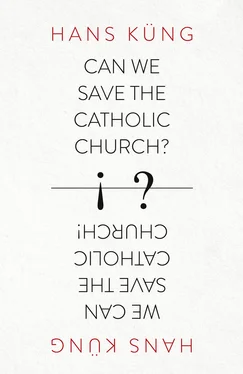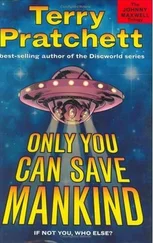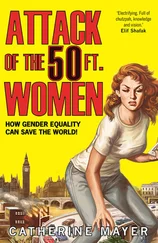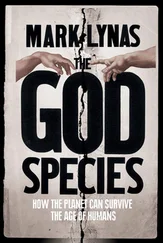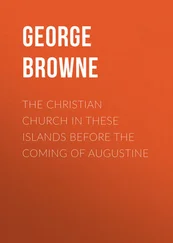I would have preferred not to write this book because, despite this time of great hope and promise, it will not make pleasant or comfortable reading for many Catholics. And it is not at all pleasant for me, either, to address such a critical publication to the people who make up the Church, because, despite my often painful and bitter experiences with the merciless Roman System which up to now has governed the Church, the Catholic community of faith remains my spiritual home. But it is my hope that the recommendations in this book will aid the Church’s recovery from what I see, and what I will go on to describe, as a debilitating and potentially terminal illness from which the Church is presently suffering.
For decades now, with mixed success at best and with virtually no impact at all on the Church’s hierarchy, I have repeatedly called attention to the serious, growing crisis within the Catholic Church, pointing out that it is primarily a crisis of the Church’s leadership and not of the faithful, as many in the hierarchy would have us believe. In recent years, however, the revelations of countless cases of sexual abuse by Catholic clergymen – cases that have been occurring for decades and which have been consistently hushed up both by Rome and by bishops around the world – has made this systemic crisis clearly visible to the world at large, and calls for a well-thought-out theological response. With Pope Francis’s appointment of a panel of cardinals to advise him on a reform of the Roman Curia (the machinery of power surrounding the pope in the Vatican), such a theological response is now more urgent than ever to support the voices of many people within the Church who have long been crying out for change.
A reform of the Curia presents us, at this fiftieth anniversary of the Second Vatican Council, with an opportunity to effect a paradigm shift in the Catholic Church. Under Popes Karol Wojtyla and Joseph Ratzinger, over the last three decades, a course of restoration to pre-Council times, rather than reform, was pursued relentlessly and this continues to exert an increasingly dramatic and deadly influence not just within the Catholic Church but also within the whole Christian ecumenical movement. Benedict XVI’s pontificate was, for me, a pontificate of missed opportunities. None of his triumphal appearances and journeys (whether staged as ‘pilgrimages’ or ‘state visits’), none of his brilliant encyclicals, nor his communication offensives, could hide the existence of the long-standing crisis in which the Church now finds itself. In the Federal Republic of Germany alone, in the last five years, hundreds of thousands of people have left the Church, and the population generally is becoming increasingly estranged from church institutions of any kind.
I repeat: I would have preferred not to write this book. In fact, I would not have written it, if:
• my hope that Pope Benedict would lead our Church forward in the spirit of the Second Vatican Council had not been so thoroughly destroyed. Back in 2005, in our four-hour, private and friendly conversation in Castel Gandolfo, my former Tübingen colleague seemed to hold out such a promise. Instead, however, Benedict obstinately adhered to the path of restoration pursued by his predecessor, distancing himself from the Council’s spirit in important points and from the many faithful Catholics whom the Council inspired. Furthermore, Ratzinger signally failed in his handling of the sexual abuses committed by Catholic clergymen all over the world.
• the bishops had exercised their collective responsibility for the Church as a whole – a responsibility explicitly acknowledged and encouraged by the Vatican Council – and had themselves vigorously spoken out and taken effective action against the scandals in the Church. Instead, however, under Wojtyla’s and Ratzinger’s rule, most of them became subservient once again to the Vatican, only too eager to toe the line without attempting to voice opinions of their own or to act independently. At best, they gave only hesitant and unconvincing answers to questions raised by the modern challenges facing the Church.
• the theologians had, as in former times, strongly and publicly stood together to oppose Rome’s new repressive measures and its attempts to control the selection of the next generation of teachers in university faculties and seminaries. Instead, however, most Catholic theologians, fearing censure and marginalization, now skirt around taboo topics of dogmatic or moral theology rather than face up to them in an unbiased and critical manner. Only very few, therefore, dare to support the global and grassroots Catholic reform organizations such as We are Church, Call to Action and, in Ireland, the Association of Catholic Priests.
To make matters worse, the advocates of reform in the Roman Catholic Church receive little support from Protestant theologians and church leaders, many of whom consider the reform issues to be a purely internal affair of the Catholic Church. All too often, they are content to cultivate cosy, friendly relations with the Vatican instead of exercising the freedom of a true Christian to speak out when needed. In the latest disputes about the Catholic Church and other churches, just as in other public discussions, lively theological discussion and fruitful controversy play only a minor role; thus the theologians miss their opportunity to issue a vigorous call for much-needed reform.
From many quarters, I have been urged to take a strong and clear stand on the current and future condition of the Catholic Church. And so, rather than writing individual newspaper columns and articles, I have decided to pen this compact summary to set forth and justify my carefully considered view of the crux of this crisis: namely that the Catholic Church – this great community of faith – is seriously ill, suffering under the Roman system of rule, a system which developed during the second millennium and which, despite opposition, remains in place today.
As I will show later, this Roman system of rule is characterized by a monopoly on power and truth, by legalism and clericalism, by hostility to sexuality, by misogyny and by clerical use of pressure on the laity. This system is not exclusively responsible for (though it does bear the main responsibility for) the three great divisions, or schisms, of Christianity: first, the East–West schism in the eleventh century, dividing the Western from the Eastern branches of the Church; then, the Reformation schism in the sixteenth century, dividing the Western (i.e. Roman Catholic) Church from the Protestant churches; and, finally, in the eighteenth and nineteenth century, the separation of Roman Catholicism from the enlightened modern world.
To begin, let me make one thing clear: I am an ecumenical theologian concerned with the Church in all its manifestations, and I am by no means fixated exclusively on the figure of the pope. In my book Christianity: Its Essence and History (1995), I devoted over 1,000 pages to a description and analysis of the history of Christianity as a whole. But it cannot be denied that the papacy is the central element of the Roman Catholic paradigm, and it is the papacy and its power that is primarily and urgently in need of reform.
The papacy as it took shape in the Christian Church of the first centuries, i.e. as a ministry in succession to St Peter, was and remains to this day a meaningful institution for many Christians, not just Roman Catholics. But, from the eleventh century onwards, this institution gradually morphed into the monarchical–absolutist papacy that has dominated the history of the Roman Catholic Church ever since. It is this monarchical–absolutist papacy that has been responsible for the three great schisms mentioned above. Ever since the Middle Ages, the growing power of the papacy within the Catholic Church, notwithstanding numerous political setbacks and cultural defeats, has become the crux of the Roman Catholic Church’s history. Thus, Catholicism’s contemporary neuralgia is not a problem of liturgy, theology, lay piety, monastic rules or art, but rather a problem linked to the very constitution of the Roman Catholic Church. In traditional histories of the Catholic Church, however, far too little critical attention has been given to the problems generated by how the papacy has developed. For this reason, I will examine these problems with special care in the present book, not least because of their explosive ecumenical significance, for their consequences are not confined to the Roman Catholic Church alone; they also affect the other Christian denominations, the dialogue with other religions and ideologies, and the relationship of the Catholic Church to the modern world as a whole.
Читать дальше
